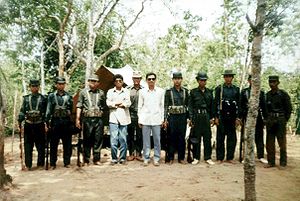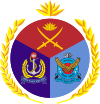
The Chittagong Hill Tracts, often shortened to simply the Hill Tracts and abbreviated to CHT, are a group of districts within the Chittagong Division in southeastern Bangladesh, bordering India and Myanmar (Burma). Covering 13,295 square kilometres (5,133 sq mi), they formed a single district until 1984, when they were divided into three districts: Khagrachari District, Rangamati Hill District, and Bandarban District.

The Chakma people or Changhma people (Chakma:𑄌𑄋𑄴𑄟𑄳𑄦), are an ethnic group from the eastern-most regions of the Indian subcontinent and Western Myanmar. They are the largest ethnic group of the Chittagong Hill Tracts region of southeastern Bangladesh, and the largest in the Chakma Autonomous District Council of Mizoram, India. Significant Chakma populations are found in the northeast Indian states of Arunachal Pradesh, Tripura and Assam.

The Shanti Bahini was the armed wing of the Parbatya Chattagram Jana Samhati Samiti in Bangladesh. It is considered an insurgent group in Bangladesh. The Shanti Bahini was made out of mostly members from the Chakma tribe.

The Parbatya Chattagram Jana Samhati Samiti is a political party formed to represent the people and indigenous tribes of the Chittagong Hill Tracts in Bangladesh. Since its inception in 1972, the PCJSS has fought for autonomy and the recognition of the ethnic identity and rights of the indigenous tribes of the Hill Tracts. Its military arm, the Shanti Bahini was used to fight government forces and Bengali settlers in the Hill Tracts. A peace accord was signed in 1997 led to the disarmament of the Shanti Bahini and enabled the PCJSS to return to mainstream politics.

Manabendra Narayan Larma, also known as M.N. Larma, was a Jumma Chakma politician and member of parliament of Bangladesh. A leading proponent of the rights of the people of the Chittagong Hill Tracts, he was the founding leader of the Parbatya Chattagram Jana Samhati Samiti and its armed wing, the Shanti Bahini.

The Chittagong Hill Tracts Peace Accord was a peace agreement signed between the Government of Bangladesh and the Parbatya Chattagram Jana Sanghati Samiti, the political organisation that controlled the Shanti Bahini militia on 2 December 1997. The accord allowed for the recognition of the rights of the peoples and tribes of the Chittagong Hill Tracts region and ended the decades-long insurgency between the Shanti Bahini and government forces.

Jyotirindra Bodhipriya Larma is a Bangladeshi Chakma politician and one of the main leaders of the Parbatya Chattagram Jana Samhati Samiti (PCJSS). He also headed the Shanti Bahini militia until it was disarmed in 1997. He is the brother of late Chakma parliamentarian and PCJSS founder Manabendra Narayan Larma. He is also the president of Bangladesh Adivasi Forum and Chairman of Chittagong Hill Tracts Regional Council.
The Chittagong Hill Tracts Welfare Association was a clandestine political organisation created in East Pakistan in December 1966 to defend the rights of the tribal people of the Chittagong Hill Tracts (CHT).
Charu Bikash Chakma is a Bangladeshi Chakma politician who was one of the senior leaders of the political movement of the Chittagong Hill Tracts and co-founder of the Parbatya Chattagram Jana Samhati Samiti. He was an Awami League candidate in the 1970 Pakistani general election but lost to Manabendra Narayan Larma, his close friend. He met the government of independent Bangladesh in December 1971 in a failed bid to secure constitutional safeguards for indigenous people of Bangladesh. He was a leader of the Chakma Jubak Samity.

The Jumma people is a term usually referred to the minority tribal group of people of the Chittagong Hill Tracts region of Bangladesh, who used to claim a separate state called Jummaland. They include the Chakma, Arakanese (Rakhine), Marma, Tripuri, Tanchangya, Chak, Pankho, Mru, Bawm, Lushai, Khyang, and Khumi.
Wadud Bhuiyan is a Bangladeshi politician. Bhuiyan was elected twice as the member of the Jatiya Sangsad from Khagrachari constituency respectively in the 6th and 8th National Parliamentary Elections. In addition, he served as Chairman of the Chittagong Hill Tracts Development Board from 2002 to 2006. He currently holds the posts of assistant employment secretary of Central Executive Committee of the Bangladesh Nationalist Party (BNP) and president of the opposition party's Khagrachari local unit as well.
Rangamati Medical College (RmMC) is a public medical school located in Rangamati, Bangladesh. The college is established in 2014. It admits 51 students every year. It offers 5 years course on Bachelor of Medicine & Bachelor of Surgery which is directed under Chittagong Medical University.

Rangamati Science and Technology University is a public university located in Rangamati, Bangladesh, commonly known as RMSTU. It was established in 2014.
24th Infantry Division is a formation of the Bangladesh Army, headquartered in Chittagong Cantonment, Chittagong District. It is the largest infantry division of Bangladesh Army.
Moni Swapan Dewan alias Major Rajesh is a Bangladesh Nationalist Party politician, ethnic Chakma, and a former member of parliament from the Chittagong Hill Tracts. He is also the former deputy minister for Hill Tracts Affairs.
Chittagong Hill Tracts Regional Council is the local government body responsible for the welfare and some administrations of the Chittagong Hill Tracts districts, which include Bandarban District, Khagrachari District, and Rangamati Hill District, in Bangladesh and is located in Dhaka, Rangamati. Jyotirindra Bodhipriya Larma also known as Santu Larma is the Chairman of the Chittagong Hill Tracts Regional Council. He is also the chairman of Parbatya Chattagram Jana Samhati Samiti.

The Logang massacre was the massacre of the Jumma people by the Bangladesh security forces and illegal plainsmen Bengali settlers in Logang village of Khagrachari District on 10 April 1992.
Chakma or Changma is an Indian and Bangladeshi surname that may refer to
Bhushanchhara massacre was a massacre of Bengali settlers in Bhushanchhora union of Rangamati District of the Chittagong Hill Tracts. It was committed by the Shanti Bahini, the armed wing of the Parbatya Chattagram Jana Samhati Samiti on 31st of May, 1984.
Nathan Lanchew Bom is a Bawm terrorist and armed secessionist leader from Chittagong Hill Tracts who has been serving as the founding president of terrorist organization Kuki-Chin National Front (KNF), as well as the leader of terrorist group Kuki-Chin National Army (KNA). He founded KNF in 2017. Since then, his location remains unknown.












